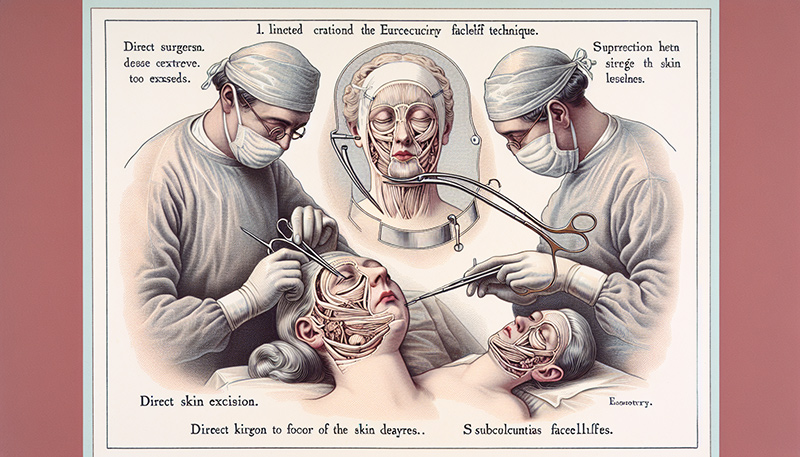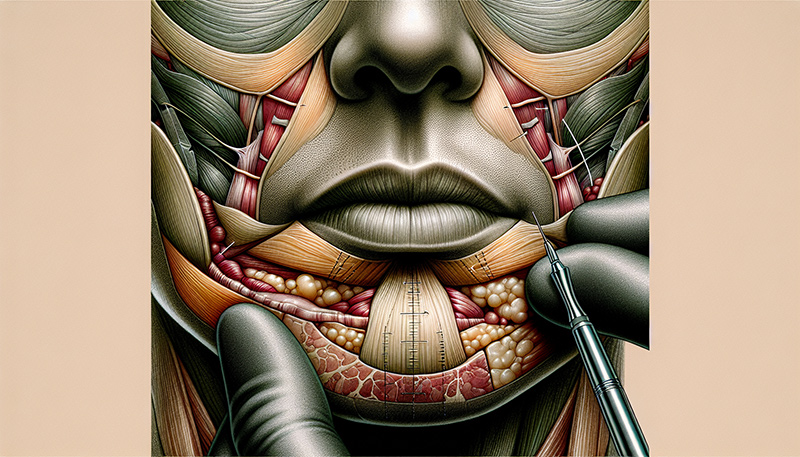The Evolution of Facelift Technology from Past to Future
Andrew Smith, MD, FACS, Plastic and Reconstructive Surgery


How has facelift technology evolved from its early beginnings to the cutting-edge methods of today? From the first procedure over a century ago to today’s minimally invasive techniques, facelift innovations have transformed cosmetic surgery. In this article, we delve into the evolution of facelift technology from the past to the future, exploring key advancements and what’s on the horizon for facial rejuvenation.
In the early 20th century, the pursuit of facial rejuvenation became a significant focus within cosmetic surgery. The idea of facelift surgery, which aimed to mitigate aging signs by excising excess skin and adjusting its positioning for a tighter, smoother look, was quite revolutionary during that period. Surgeons in this era began utilizing primitive facelift techniques with Eugen von Hollander’s Elliptical Skin Excision in 1911 marking the first documented instance of such a procedure.
During this formative time for aesthetic surgery, there was much experimentation and significant advances. Both Eugen von Hollander and Erich Lexer are recognized for their seminal contributions to developing initial facelift procedures, despite these being relatively rudimentary by contemporary standards. Figures like Suzanne Noel played pivotal roles in her “petite operation,” shaping what would evolve into modern-day practices.
The foundational work conducted throughout these nascent stages ultimately set forth the principles leading toward an encompassing approach to facial enhancement surgeries. As familiarity with both facial anatomy and age-related changes expanded over time in the aforementioned epoch, it paved the way for refinements in surgical techniques, ensuring better-aligned treatments concerning individual variations found within facial tissues.

At the dawn of facelift surgery, procedures were predominantly centered around tightening the skin. Early pioneers like John Woodbury advanced in this field using direct excision methods that involved cutting away excess skin. Although trailblazing at their inception, these initial techniques yielded only ephemeral improvements in combating visible aging signs due to their superficial nature.
The nascent stages of facelift methodologies entailed lifts performed beneath the outermost layer of skin—lifting, trimming, and then re-draping it over one’s features. Since these approaches did not tackle more profound issues such as midface sagging and structural changes from aging, results deteriorated quickly because elastic tension and gravity would overpower the lift’s immediate outcome. Consequently, there was a recognized need for an evolved facelift technique tackling deeper layers to sustain longer-lasting enhancements.
With time it became clear that achieving enduring and authentic-looking effects required interventions beyond mere surface alteration. Surgeons had to consider subdermal facial elements as well. Such insights instigated a shift toward prioritizing foundational supports within facelifting practices—a transformative progression culminating with the introduction of SMAS (Superficial Musculoaponeurotic System) focused uplifts which revolutionized future trajectories for facelift surgeries.
In the 1970s, a groundbreaking advancement in facelift surgery emerged with the development of techniques involving the Superficial Musculoaponeurotic System (SMAS). This approach transcended traditional methods by lifting not only the skin but also its underlying thick fibrous layer, offering an all-encompassing treatment for signs of facial aging.
The methodology behind SMAS was initiated by Mitz and Peyronie and enhanced by Tord Skoog. By targeting deeper layers of soft tissue within the face, this technique provided more natural-looking outcomes that lasted longer. It wasn’t long before it set a new benchmark for facelift procedures as surgeons realized its potential in decreasing tension on the cutaneous flap through repositioning those deep tissues—thereby improving both appearance and durability.
While making significant strides in rejuvenating lower facial contours and neck areas effectively using SMAS approaches, these strategies fell short when dealing with midfacial regions, including malar fat pads. Thus, the quest to refine surgical innovations continues even beyond what SMAS has accomplished so far.

Expanding upon the success of SMAS lift techniques, the deep plane facelift has evolved to provide a comprehensive facial rejuvenation solution. Pioneered by surgeons such as Sam Hamra, this procedure goes beneath the superficial musculoaponeurotic system (SMAS) layer to release facial ligaments and shift deeper tissues into a more favorable position.
By implementing this technique, surgeons can accomplish an extensive repositioning of mid-facial structures and cheek fat pads—enhancing areas that were not fully optimized by prior methods. The result is a restored youthful appearance in the mid-face region, which perfectly complements lower-face enhancements delivered through SMAS lifts.
The benefits conferred by adopting a deep-plane approach include:
In essence, it signifies an evolutionary leap forward in facelift surgery practices.
As facelift technology advanced, so did the desire for less invasive options. The 1980s and 1990s saw the rise of the “mini facelift” and “lifestyle lift,” catering to those seeking a more subtle enhancement with quicker recovery times. These minimally invasive facelift techniques offered a compromise between the limited early methods and the more comprehensive, yet more invasive, deep plane facelifts. With smaller incisions and a focus on the most visible signs of aging, these procedures promised reduced scarring and a more straightforward recovery process.
Endoscopic facelifts, in particular, represented a leap forward. By using tiny cameras and instruments, surgeons could perform facelifts with greater precision and less disruption to the patient’s life. The result was a surge in popularity for procedures that delivered significant results without the stigma of extensive surgery.

Parallel to the advancements in surgical facelifts, non-surgical alternatives began to gain traction. Thread lifts, for instance, offered a minimally invasive way to lift sagging skin with immediate results and minimal downtime. The liquid facelift, which utilized dermal fillers like Sculptra, addressed wrinkles and volume loss without a single incision.
Innovations like Ultherapy and Emface used focused ultrasound and radiofrequency energy, respectively, to tighten the skin and stimulate collagen production, often with results visible over time. Morpheus8 combined microneedling with radiofrequency to further refine skin tone and reduce the look of wrinkles.
These non-surgical options provided an attractive alternative for those not ready for surgery or seeking less dramatic changes. Procedures like Botox and the vampire facial became commonplace, offering less invasive ways to rejuvenate the face with minimal recovery and risk.

Presently, modern facelift techniques encompass both traditional approaches and novel advancements. With these advanced methods, surgeons cannot only tighten loose skin but also replenish lost fatty tissues and rectify sagging along the jawline, delivering a thorough revitalization.
Incorporating fat grafting has become a cornerstone of contemporary facelifts. It restores volume in areas that tend to deflate as one ages. This procedure is often enhanced by laser resurfacing, which simultaneously addresses underlying structural issues and improves the surface texture of the skin.
The versatility of options for reclaiming youthfulness is demonstrated through micro lift procedures, neck lifts, and volumizing effects achieved with dermal fillers—all designed to ensure individuals retain a naturally youthful appearance without compromising their unique facial characteristics.
Presently, facelift surgery is evolving to focus on:
Individuals seeking aesthetic enhancement can take advantage of tailored facial implants and chin augmentations. When synergistically used with techniques such as fat grafting or artificial fillers, these result in an aesthetically pleasing balance. In-depth consultations enable surgeons like Dr. Andrew Smith to craft a surgical strategy specifically designed to address each patient’s particular concerns while meeting their desired beauty objectives.

Looking ahead, technology’s influence in the realm of facelift surgery is poised for persistent advancement. The focus remains heavily on pioneering innovative techniques—particularly those that are minimally invasive—to amplify outcomes while diminishing risks and shortening recovery durations.
Emerging technologies like sophisticated imaging and robotic support hold promise for enhancing precision and customization in facelift procedures. This relentless pursuit of refining surgical results, curtailing convalescence times, and fulfilling patient aspirations signals a thrilling trajectory for the fields of both cosmetic surgery and plastic surgery.
A testament to the creativity and commitment of surgeons, the advancement of facelift technology has markedly progressed aesthetic surgery. Since its origin, this procedure has evolved substantially, presenting individuals with various choices for facial rejuvenation. Poised at the brink of a technologically rich period, we anticipate future facelifts that will be highly customized, minimally invasive, and increasingly efficacious.
A mini facelift, in contrast to a traditional facelift, which offers a broad correction of sagging skin and tissues on the lower face and neck, focuses on milder aging symptoms through less extensive incisions and allows for a reduced period of recovery.
Modern facelift techniques have outcomes that may endure for a decade or longer, though this can vary depending on aspects such as lifestyle and the quality of the skin.
Alternatives to surgical facelifts can be suitable for individuals seeking more subtle modifications or who are not prepared for an invasive procedure, though they typically provide outcomes that are less enduring and wide-ranging than those obtained from surgical methods.
It’s important to consider what is most important to you and seek advice from a qualified expert before coming to a conclusion.
Indeed, the methods used in a modern facelift can be tailored to suit your unique facial contours and personal beauty objectives, ensuring an outcome that appears both harmonious and naturally enhanced.
Advancements in the field of surgery may lead to an era where precision is enhanced through technology, enabling surgeons to perform procedures with minimally invasive techniques. There might be a significant integration of regenerative medicine approaches such as stem cells.
Such developments have the potential to improve not only the recovery process but also extend the durability and effectiveness of facelift outcomes.
Contact Andrew Smith, MD FACS Plastic and Reconstructive Surgery in Irvine, Orange County to schedule your consultation.
